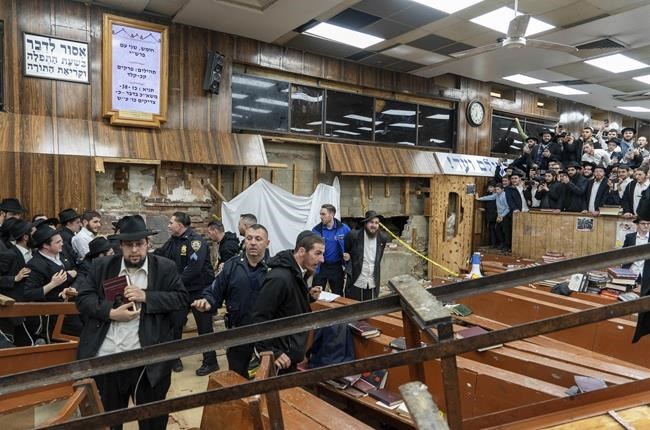
FILE - Hasidic Jewish students riot against New York Police officers who were called to inspect a secret tunnel dug under the synagogue by students, Monday, Jan. 8, 2024, in New York. A group of Hasidic Jewish worshippers were arrested amid a dispute over a secret tunnel built beneath the historic Brooklyn synagogue, setting off a brawl between police and those who tried to defend the makeshift passageway. (Bruce Schaff via AP, File)
Republished January 11, 2024 - 3:54 PM
Original Publication Date January 11, 2024 - 2:06 PM
The basement synagogue that was the scene of a brawl this week between worshippers and New York City police has a long and storied connection with a Brooklyn rabbi who led a global movement and remains revered three decades since his death.
The fight broke out Monday when authorities moved in to seal off a secret tunnel into the Chabad-Lubavitch synagogue, which some worshippers — described by the movement as “a small group of rogue youth” — said was intended to fulfill the wishes of Rabbi Menachem Mendel Schneerson.
Here are some details about Schneerson and his impact within and beyond the Chabad-Lubavitch movement of Orthodox Judaism.
WHO WAS SCHNEERSON?
Schneerson led Chabad-Lubavitch from 1951 until his death in 1994. He was the movement’s seventh leader, know as Lubavitcher Rebbe.
He arrived in the United States during World War II after gaining a secular education in Europe, and he quickly set about rebuilding Chabad-Lubavitch and wider Jewish observance following the devastation of the Holocaust.
Schneerson’s voluminous speeches and writings were spread widely and continue to be collated and studied by supporters.
He sought to expand Jewish observance, dispatching emissaries throughout the world, often in places with little to no Jewish presence. And he would encourage people of all faiths to be more observant and to heed universal moral teachings about honoring God and respecting others.
On Sundays, Schneerson would hand out crisp dollar bills to people who lined up for hours to see him. The bills were supposed to be given to charity, but many kept them as souvenirs, according to his 1994 obituary by The Associated Press. Many who met him in person came away with stories of his charisma and his encyclopedic memory for names and details.
"Reverence for the rebbe along those lines is standard" in any Hasidic community, said Ezra Glinter, who is writing a biography of Schneerson for Yale University Press. “But he did have a broader influence than most Hasidic rebbes do. These kinds of stories really did exceed the boundaries of his own community.”
Even before his death, some followers regarded Schneerson as a messianic figure, and some believe now that he hasn’t really died or that he will be resurrected to complete his work.
The Chabad movement disavows any teaching that Schneerson is the messiah. Still, his memory is honored throughout the movement and beyond, and his grave in Queens receives about 400,000 visitors per year, according to Chabad.
WHAT IS CHABAD-LUBAVITCH?
No one has succeeded Schneerson as rebbe in the 30 years since his death, but the movement continues to expand and has become the most outward-looking of Hasidic or strictly observant Orthodox Jewish groups.
The movement's global headquarters in Crown Heights, Brooklyn, are a deeply revered Jewish site visited by thousands of people a year, including international students and religious leaders. Its Gothic Revival facade has inspired dozens of replicas across the world.
The movement continues to send representatives to college campuses, public squares and other venues to encourage less-pious Jews to become more observant. Its large Hanukkah celebrations have become an annual tradition across the United States and elsewhere, complete with giant menorahs paraded on car rooftops and displayed in other public settings.
Husband-and-wife emissaries, known as shluchim, work around the world, providing a Jewish presence even where it is otherwise sparse. Their massive group photos have become a tradition at annual meetings in New York.
WHAT HAPPENED AT CHABAD?
Officials and locals said some young members of the movement had dug a 60-foot tunnel to the basement synagogue in secret. When the group’s leaders tried to seal it off Monday, the men staged a protest that turned violent as police moved in to make arrests.
Within days, New York building officials issued emergency work orders to stabilize the synagogue and its neighboring structures, worrying that the illicit underground tunnel may have caused structural damage. Authorities ordered the evacuation of some of the buildings because of safety concerns and issued citations to the buildings' owners.
Tunnel supporters said they believe Schneerson is the messiah, that he is still alive and that he supports an expansion of the synagogue.
For Schneerson, the Brooklyn complex had “a lot of symbolic and religious significance,” as the place where he and his predecessor had taught and worked, Glinter said. The rebbe had goals for an expansion in the 1980s and 1990s, seeing it as “further preparatory act for the messiah’s arrival,” Glinter said.
That expansion didn’t come to fruition, he said. “It seems to me quite likely the people doing this believed they were in fact fulfilling Schneerson’s wishes.”
Rabbi Motti Seligson, spokesman for Chabad, described those involved in the digging of the tunnel and the subsequent disorder as “young agitators,” but conceded that everyone supports an expansion at some point. “This is a small group of rogue youth who have sadly caused an enormous amount of pain and damage,” he said.
“This is a place where the rebbe taught and inspired a generation to be kinder, to be better, to become the best version of themselves," Seligson said. "For this to happen in this sacred space is incredibly painful.”
___
Associated Press religion coverage receives support through the AP’s collaboration with The Conversation US, with funding from Lilly Endowment Inc. The AP is solely responsible for this content.
News from © The Associated Press, 2024